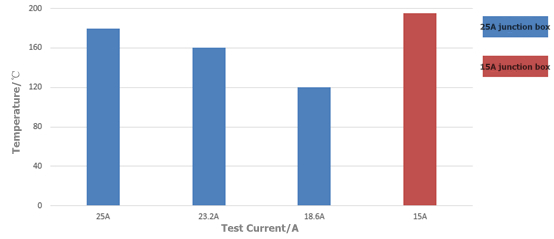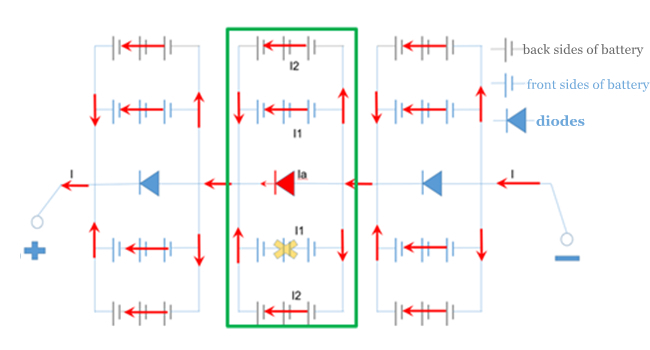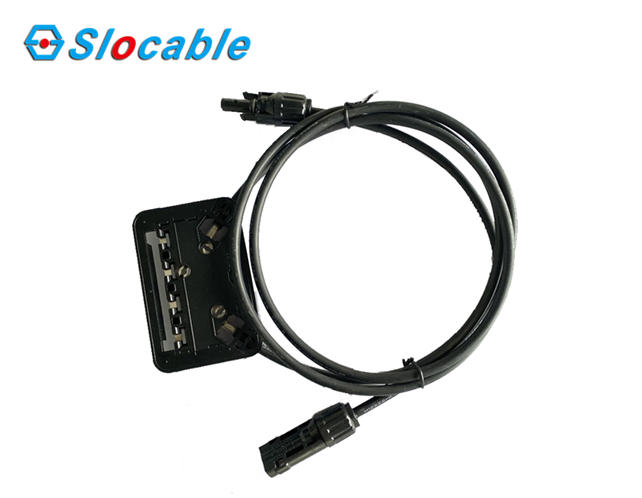With the mass production of 166, 182, and 210 photovoltaic modules, the industry continues to discuss the advantages and disadvantages of silicon wafer size changes. The focus of the discussion includes the electrical parameters and dimensions of the modules, transportation, and raw material supply. Of course, there are also some discussions on the reliability and material selection of photovoltaic junction boxes. As a material supplier engaged in the research and development and manufacturing of junction boxes for a long time, we analyze the relationship between junction boxes and large-size silicon wafers and high-power modules from a material perspective.
Working Principle of Photovoltaic Junction Box
The main function of the photovoltaic junction box is to output the power generated by the photovoltaic module to the external circuit, including the shell, diode, mc4 connector, photovoltaic cable and other components, among which the diode is the core device. When the module is working normally, the diode in the PV junction box is in the reverse blocking state; when the module cell is blocked or damaged, the bypass diode is turned on to protect the entire photovoltaic module.
| PV Module Type |
Module Power |
Module Isc |
Module String Voc |
Rated Current of Junction Box |
| 166 Series PV Modules |
450W |
11.5A |
16.5 |
16, 18 or 20A |
| 182 Series PV Modules |
530W |
13.9A |
16.5V |
20, 22 or 25A |
| 590W |
13.9A |
17.9V |
| 210 Series PV Modules |
540W |
18.6A |
15.1V |
25 or 30A |
| 600W |
18.6A |
13.9V |
The above table shows the typical electrical performance parameters of 166, 182 and 210 modules and the selection of rated current of photovoltaic junction box of photovoltaic module factory. The module parameters show low current, high voltage and high current and low voltage respectively.
Photovoltaic Junction Box and Diode
The key indicators of photovoltaic junction box include junction box rated current, diode rated current and reverse withstand voltage, etc., depending on the structure design of the junction box and the selection of diode specifications.
Generally, the certification and testing of photovoltaic modules and junction boxes are based on: the rated current of solar junction boxes ≥ 1.25 times Isc for selection and testing, and a certain margin will be reserved. Under normal working conditions, the junction box diode is in the reverse cut-off state. Regardless of the 166 and 182 components or 210 components, the diodes will not conduct or heat. Compared with the 210 components, the junction box diodes of the 182 and 166 components will bear slightly High reverse bias voltage.
When a hot spot occurs in a photovoltaic module, the diode will conduct forward and generate heat. Take the 210 module and the 25A junction box as an example, when the output current Isc=18.6A (the current when the actual module is working is Imp≈17.5A), the junction temperature is about 120°C. Even considering a part of the environment with sufficient light, in the case of 1.25 times Isc (23.2A), the junction temperature of the photovoltaic junction box at this time is about 160°C, which is far lower than the 200°C junction temperature upper limit of the IEC62790 standard. Of course, the Isc for modules 182 and 166 is slightly lower, and the junction box with the same configuration has lower heat generation, and the junction boxes are in a safe working state so there is no risk.

The above analysis is the operation of the photovoltaic junction box in the case of hot spots in the photovoltaic module. As for the modules, when birds or leaves block the hot spots and quickly disappear, the diode thermal escape will occur. The module string will bring instantaneous reverse bias voltage and leakage current to the diode, and higher string voltage will bring greater challenges to the junction box and diode. From the perspective of PV junction box design, reasonable box structure design, easy heat dissipation diode packaging and better chip selection can solve these problems.
For double-sided modules and half piece modules, since each unit side is connected in parallel with each other, as shown in the figure below, when local hot spot effect and heat escape occur, the parallel part can be shunted, and the safety margin reserved by the junction box is even greater. According to calculations, the probability that the parallel sides, front and back sides of the double-sided half-cell module are simultaneously blocked is extremely low, which is about the incidence of 1 module in 10GW. Therefore, under actual conditions, it is almost impossible to have the junction box working at full load, and reliability can be guaranteed.

Photovoltaic Connectors and Cables
As one of the power transmission components, the photovoltaic connector is responsible for the successful connection of the power station. At present, the rated current of mainstream connectors commonly used in the market are all higher than 30A, and the maximum can reach 55A, which is sufficient to meet the power transmission requirements of existing high-power components. It has been verified that in a 55A module reverse current overload test of a photovoltaic connector with a rated current of 41A from a manufacturer, the monitored temperature is 76°C, which is much lower than the 105°C RTI value of the raw material of the connector. However, in the high-current application environment, the connector end should also try to avoid potential problems such as current limitation caused by local high resistance and local contact point overheating. Effective solutions, such as: optimizing the contact performance of the conductor ring, improving the overall structure of the connector, improving the quality of the cable crimping at the connector end, and adding tin double insurance technology to the connecting part.
For photovoltaic cables, the rated current of cables that comply with EN or IEC standards (4mm2 cables, the rated current is 44A when the surfaces are adjacent to each other) is much higher than the rated current of the photovoltaic junction box, so there is no need to worry about its reliability.

PV Junction Box Manufacturing Process and Market Overview
With the steady improvement of the manufacturing level and quality control capabilities of photovoltaic junction boxes, the performance and reliability of junction boxes have been well guaranteed, which can meet the requirements of large-size silicon wafers and high-power components.
1. In the design and manufacturing process of photovoltaic junction box, a large number of new processes and new technologies that have been verified in the fields of semiconductor, automobile, aerospace, etc. are introduced, such as module packaging technology, intermediate frequency welding technology, etc., to improve the electrical performance and heat dissipation of junction box products ability.
2. In the PV panel junction box manufacturing process, increasing the research and development and investment of automation equipment can ensure the processing accuracy, quality, and process controllability, and achieve process automation and quality control automation.
3. Based on the PV junction box manufacturing experience, focus on strengthening the control of the connection reliability between the accessories of the junction box and the management of key quality control points, such as the control of the compression ratio at the connection point, the double insurance process requirements for tinning, and the ultrasonic welding process control , Corona treatment, and monitoring of important parameters.
In addition to the improvement of photovoltaic junction box manufacturers’ own capabilities, component manufacturers and third-party organizations are constantly improving the testing, evaluation and quality control of junction boxes and components, which has further promoted the improvement of the quality control and R&D capabilities of junction box manufacturers.
Starting from the first half of 2020, certification bodies such as TUV have issued 25A and 30A junction box certification certificates to many PV junction box manufacturers. Batches of large-current junction boxes have passed the certification and testing of third-party agencies, which has further strengthened the confidence of junction box manufacturers and photovoltaic module manufacturers. With the release of the production capacity of 182 and 210 large silicon wafer modules, the supporting production capacity of large current junction boxes will also be gradually established and expanded.
In summary, the performance, reliability assurance and manufacturing capabilities of high-current photovoltaic junction boxes and components are mature, and they can fully meet the requirements of different types of large-size silicon wafers and high-power components.



 2021-09-16
2021-09-16

















